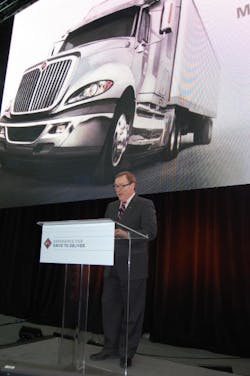“We have not had one of these meetings for three years,” Troy Clarke, Navistar president and CEO observed, noting that the company had to make many adjustments, but that "it is time to resume our annual analysts meetings. From adversity comes strength. I am personally convinced our best days are ahead.”
In the past, Navistar's future plans had focused largely on its exhaust gas recirculation (EGR) engine, but that did not come to pass, Clarke (seen at right during the 2013 Mid America Trucking Show) noted. "Now our transition to SCR [selective catalytic reduction] is complete and our data shows us that the trucks we are building are the best in more than a decade," he said.
"We also had warranty issues and we saw market share decline. As of today, however, we have accomplished 'ten years of progress' in the last two years,” Clarke noted, listing key achievements including an improved cash position and lowered breakeven point, improved product quality, reduced warranty costs, the initiation of lean practices and consolidated manufacturing, significant restructuring and attracting “good people” to the organization, especially strong leadership.
“Now we’ve got to build on this,” Clarke said.
Walter Borst, Navistar executive vice president and CFO, delivered the financial report, stressing - as other speakers did throughout the meeting - the progress the company has made.
He noted that North American revenues increased approximately 10% with margins also up in 2014. Core North American revenue (not including defense or the Blue Diamond trucks) increased from $6.1 billion in 2013 to $6.7 billion in 2014, thanks to a 6,400 unit sales increase, Borst reported. Total revenue of $10.8 billion was flat year over year, however, as the company experienced declines in defense and their global truck operations, most notably in Brazil.Thanks to a four-pronged cost approach to improving returns, which included lowering material, structural, manufacturing and warranty costs, the company has lowered the breakeven point by more than 50% since 2012, Borst (at left) noted, with margins increasing to 3.9% in the fourth quarter last year from 0.2% in the same period back in 2013. For 2015, Borst said Navistar's target margin is between 8% and 10%.
He added that core North American truck revenue is expected to increase in 2015 to between $6.9 billion and $7.2 billion in conjunction with overall industry growth and market share gains, while noting that the Blue Diamond truck venture is scheduled to wind down this spring and that the market in Brazil is not expected to recover this year.
According to Borst, there was an intense focus to drive Navistar's structural costs down to less than 10% of manufacturing revenue. Structural costs measured as a percentage of revenue were 15% in 2013, dropping to 12% in 2014. The 2015 goal is to move structural costs down further to between 10% and 11% of manufacturing revenue.
Warranty expense as a percent of revenue also dropped in 2014, Borst added, surpassing the 3.7% target and trending down. The target for 2015 is 3.3% to 3.7%.
Gross material savings and manufacturing savings also contributed to overall cost reduction. Consolidation of mid-range engine operations and closure of foundry operations alone will deliver $35 million in savings, Borst said.
For 2017 and beyond one of Navistar's goals will be to improve the balance sheet, including reducing cash requirements and continuing to drive margins toward industry benchmarks. Capital spending is not expected to return to historic levels, Borst pointed out, although it will increase as the company continues to invest in its products. 2014 capital spending was $88 million. 2015 is expected to be $125 to $150 million.
Navistar also announced during the meeting that the company is now focusing on “maximizing customer uptime.” "Uptime means more than designing and building trucks to stay on the road longer," said Bill Kozek, Navistar president, Truck and Parts. "It's our renewed commitment to the industry to deliver innovation, tools and services that keep our customers moving.
Other meeting highlights:
- OnCommand: This remote diagnostics capability is considered to be “a key contributor to uptime,” according to Kozek, and the company plans to continue to release enhancements. In an earlier interview with Fleet Owner, Mike Cerilli, vice president and general manager, Connected Vehicle for Navistar, said, “Remote diagnostics in our industry is really still in its infancy. It will be a core competency for OEMs [in the near future]. Today, we are ranking fault codes and turning unscheduled maintenance/repair events into scheduled events.” Navistar made the decision to offer an “open architecture,” he noted, and today they integrate with some 85% of telematics providers. Kozek added that OnCommand, while initially developed with the over the road trucking market in mind, will launch into other market segments, including the bus segment. This spring, the new bus offering will include special custom features such as vehicle monitoring and student tracking.
- Used trucks: Overall, the industry’s used truck business is very strong, Kozek noted during the meeting. Navistar has 24 used truck centers and the ability to take trades is important to supporting the new truck business. Our used inventory is expected to “peak this year and begin to normalize after 2017,” he said.
- Parts and customer service: Michael Cancelliere, senior vice president, global parts and customer service for Navistar, noted in his meeting presentation that, “This relentless focus on uptime is what will differentiate us…customers want us to get them in [for service], get them fixed, and get them out quickly.” Accordingly, a 25% dwell time reduction is a goal. Navistar is well-positioned to deliver on this goal, he noted, with over 800 dealerships, 8,000 service bays, 7,600 technicians and an inventory of some $350 million in parts. “Parts will remain a key component of corporate profitability and cash generation and play a key role in uptime,” Cancelliere added.
- Engines: During a question and answer period, the subject of Navistar’s engine business came up. Clarke said that, for now, Navistar will stay in the engine business because the current engines will be in compliance through 2020 and the company has taken considerable cost out of their 13-liter engine. "When we are faced with the next need for significant investment to meet the next level of regulations, we’ll evaluate this business again," he added.
- New product development: "Some of our competitors are promoting vertical integration, and we used to have a 'go it alone' approach," observed Dennis "Denny" Mooney, senior vice president global product development for Navistar. "But we are taking another approach today and that is to leverage the best global suppliers. Today, sharing technology makes sense.” The company has relationships with Eaton, Allison, Bendix, Meritor Wabco, Cummins and many others, Mooney said, and that brings with it "numerous benefits," including access to the latest technologies, speed to market and customer choice. This partnership approach also reduced the company’s product development spend by more than $200 million from 2012 to 2014, he pointed out. Mooney also noted that a "full line of new products will be rolling out over the next several years," including a new line of “premium vocational trucks.”





